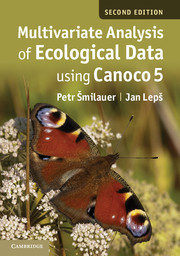Book contents
- Frontmatter
- Contents
- Preface
- 1 Introduction and data types
- 2 Using Canoco 5
- 3 Experimental design
- 4 Basics of gradient analysis
- 5 Permutation tests and variation partitioning
- 6 Similarity measures and distance-based methods
- 7 Classification methods
- 8 Regression methods
- 9 Interpreting community composition with functional traits
- 10 Advanced use of ordination
- 11 Visualising multivariate data
- 12 Case study 1: Variation in forest bird assemblages
- 13 Case study 2: Search for community composition patterns and their environmental correlates: vegetation of spring meadows
- 14 Case study 3: Separating the effects of explanatory variables
- 15 Case study 4: Evaluation of experiments in randomised complete blocks
- 16 Case study 5: Analysis of repeated observations of species composition from a factorial experiment
- 17 Case study 6: Hierarchical analysis of crayfish community variation
- 18 Case study 7: Analysis of taxonomic data with discriminant analysis and distance-based ordination
- 19 Case study 8: Separating effects of space and environment on oribatid community with PCNM
- 20 Case study 9: Performing linear regression with redundancy analysis
- Appendix A Glossary
- Appendix B Sample data sets and projects
- Appendix C Access to Canoco and overview of other software
- Appendix D Working with R
- References
- Index to useful tasks in Canoco 5
- Subject index
17 - Case study 6: Hierarchical analysis of crayfish community variation
Published online by Cambridge University Press: 05 May 2014
- Frontmatter
- Contents
- Preface
- 1 Introduction and data types
- 2 Using Canoco 5
- 3 Experimental design
- 4 Basics of gradient analysis
- 5 Permutation tests and variation partitioning
- 6 Similarity measures and distance-based methods
- 7 Classification methods
- 8 Regression methods
- 9 Interpreting community composition with functional traits
- 10 Advanced use of ordination
- 11 Visualising multivariate data
- 12 Case study 1: Variation in forest bird assemblages
- 13 Case study 2: Search for community composition patterns and their environmental correlates: vegetation of spring meadows
- 14 Case study 3: Separating the effects of explanatory variables
- 15 Case study 4: Evaluation of experiments in randomised complete blocks
- 16 Case study 5: Analysis of repeated observations of species composition from a factorial experiment
- 17 Case study 6: Hierarchical analysis of crayfish community variation
- 18 Case study 7: Analysis of taxonomic data with discriminant analysis and distance-based ordination
- 19 Case study 8: Separating effects of space and environment on oribatid community with PCNM
- 20 Case study 9: Performing linear regression with redundancy analysis
- Appendix A Glossary
- Appendix B Sample data sets and projects
- Appendix C Access to Canoco and overview of other software
- Appendix D Working with R
- References
- Index to useful tasks in Canoco 5
- Subject index
Summary
Biotic communities vary at multiple spatial (and temporal) scales, often hierarchically related. To understand this variation, including its relation to biotic and abiotic factors, we must start with testing the variation's existence and quantifying its extent at particular scales. In this chapter, you will study the hierarchical components of spatial variation of the crayfish community in the drainage of Spring River, north central Arkansas and south central Missouri, USA. The data were collected by Dr Camille Flinders (Flinders & Magoulick, 2002). The statistical approach used in this study was already described in Section 10.4.
Data and design
The primary data table consists of 567 records of the crayfish community composition. There are 10 variables, which actually represent only five crayfish species, with each species divided into two size categories, depending on carapace length (above or below 15 mm). The data matrix is quite sparse. In the 5670 data cells, there are only 834 non-zero values; 85% of the data cells are empty. This would suggest high beta diversity and, consequently, use of a unimodal ordination, such as CCA. There is a problem with that choice, however. There are 133 records without any crayfish specimen present and such empty cases are uninformative with respect to species composition. They cannot be compared with the other records using the chi-square distance, which is implied by unimodal ordination methods. If you use a unimodal ordination, the empty records will be automatically omitted from the analysis and some of the permutation tests shown in this case study will not work, due to the introduced unbalancedness of the data. You must, therefore, choose the linear ordination and rely on its robustness.
Information
- Type
- Chapter
- Information
- Multivariate Analysis of Ecological Data using CANOCO 5 , pp. 301 - 308Publisher: Cambridge University PressPrint publication year: 2014
